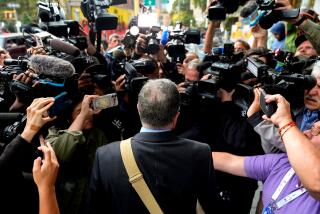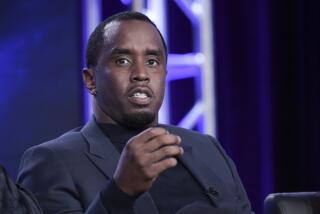‘Wrong-Man’ Defense Falters in Cosby Murder Case
As the Mikail Markhasev murder trial moved toward a conclusion last week, the lawyer for the man accused of killing Bill Cosby’s son made a final attempt to pin the killing on someone else.
Markhasev’s attorney, Deputy Alternate Public Defender Henry Hall, approached Superior Court Judge David D. Perez on Thursday for a sidebar conference, out of the jury’s hearing. Perez, a stern, efficiency-minded jurist, has kept such conferences short during the three-week trial.
Nevertheless, Hall, whose cross-examination has been noteworthy at times for its intricacy, argued at length.
You must, he said, permit Kathleen Bias, a defense witness who had been on the stand, to testify about a conversation she had with Eli Zakaria, who was with Markhasev on the night of the murder. In that conversation, Hall said, Zakaria seemed to admit he had been the murderer.
Hall told Perez that when Bias said to Zakaria, “You killed him, didn’t you?” Zakaria “basically put his head down, turned around and walked away.” An innocent person would have denied the charge, Hall said. Hall also told the judge that Bias was prepared to testify that Zakaria told her “the state is going to send an innocent man to prison.”
But Perez refused to admit the testimony.
“I don’t think it rises to the threshold where it’s trustworthy,” he said.
Loyola University law professor Stanley Goldman said the defense has consistently failed to show that Zakaria committed the murder. That means, Goldman said, that defense attorney Hall has not kept the promise he made to the jury at the trial’s outset--to prove that “the person who really did the killing in this case was Eli Zakaria.”
With that defeat for the defense, both sides prepared for final arguments today in a crime story that began with the murder of Ennis Cosby after he stopped to change a tire near Mulholland Drive and the San Diego Freeway early in the morning of Jan. 16, 1997.
Blaming Zakaria for killing Cosby, a 27-year-old doctoral student who was on winter break from Columbia University Teachers College, was the central theme of the defense’s case. It will be one of several issues Hall and his partner, Deputy Alternate Public Defender Harriet Hawkins, are expected to address in their closing arguments.
But, the dearth of evidence to support that theme probably will be an argument that the prosecutor, Deputy Dist. Atty. Anne Ingalls, will pound on in her closing statements.
Ingalls says that Zakaria, his girlfriend Sara Ann Peters and Markhasev were using the telephones at a park-and-ride lot on Skirball Center Drive near where Cosby had pulled over to change the tire shortly after 1 a.m.
She has maintained that the 19-year-old Markhasev intended to rob Cosby but ended up killing him, and that the threesome then fled, ditching the gun in a wooded area about five miles away.
A few days later, Markhasev enlisted the help of Michael Chang, a former cellmate in juvenile hall, and Christopher So, Chang’s friend, in an unsuccessful search for a gun in the same wooded area.
So said he heard Markhasev tell Chang he shot Cosby.
Police later found the murder weapon in that area, wrapped in a knit cap containing strands of Markhasev’s hair.
Trial Has Mystery but Little Emotion
From the outset, the trial has been a classic whodunit in the Perry Mason mold, but without the flash and emotion of that old courtroom television drama.
Except for the brief tears and breaking voice of one minor witness, there were no emotional breakdowns on the witness stand and no theatrical orations or hard-hitting cross-examinations. Ingalls talked in a low monotone. The defense lawyers frequently asked long, contorted questions and lapsed into intricate cross-examinations.
The jurors sat stone-faced, but attentive, jotting notes while listening to the witnesses.
But testimony was intriguing, as was the colorful cast of characters who appeared on the witness stand.
They exposed jurors to a seamy side of the world, where a friend is a “dog” and a gun is a “strap” and every other word in a conversation is accompanied by an obscenity.
Jurors saw the mysterious, silent appearances of young street toughs such as Zakaria and Chang. Chang sat in the witness chair for a few moments, but refused to testify and was held in contempt. Zakaria was paraded in front of the jury, a silent support to the prosecution’s argument that he doesn’t resemble the early descriptions of the killer. But he said nothing, invoking his 5th Amendment right not to incriminate himself.
They saw the red-haired Stephanie Crane, billed in the tabloid press as the mystery woman who was with Cosby the night he was killed. She had appeared in television footage and photographs of the murder scene as a grainy image in a fur coat.
They saw Victoria Markhasev, the nervous mother of Markhasev, desperately trying to give her son an alibi only to get hopelessly entangled in contradictions.
They heard about the strange partying at a mansion on Mulholland Drive where people lived rent-free, moving in and out. It is less than two miles from the murder scene, and Markhasev, Zakaria and Peters were there until 55 minutes before Cosby was killed.
And, they got a peek at life inside Men’s Central Jail through the incriminating letters that Markhasev allegedly wrote to other inmates.
But what appeared to make the greatest impression on jurors was a secretly recorded telephone conversation between Markhasev, who was at home, and Chang, the friend who allegedly helped Markhasev in the unsuccessful gun search.
Laced with obscenities and talk of drugs and taking care of “rats,” the phone conversation depicted a frantic, angry and suspicious defendant denying the killing but intensely worried that the usually streetwise Chang is talking about his role in the case over the telephone.
“Shut the f--- up,” Markhasev said, when Chang asked if he ever went back to search for the gun.
Yet, despite Markhasev’s apparent suspicion that the call was a police setup--which it was--he admitted he never went back to look for the gun.
Both sides have major issues to confront in their final arguments.
Hall must deal with his failure to present testimony showing that Markhasev once told Zakaria that he was going to take the blame for the killing.
Attorneys Argue Over Description of Suspect
Hall has tried to argue that Crane’s description of the killer fits Zakaria better than Markhasev. But, at best, he and Ingalls have fought to a draw on that issue. Some of the characteristics Crane gave clearly fit Markhasev and some just as clearly fit Zakaria.
Hall and Hawkins also have a major problem with the jailhouse letters.
In one letter talking about the attempted robbery of Cosby and signed with his gang moniker, “PWee,” Markhasev allegedly says Zakaria knew about the crime, but “there was no partner. I went to rob a connection, but obviously found something else.”
In another, “PWee” writes: “There’s a vato [a person] in Bel-Air that sells coke. I was supposed to take him out. . . . The vato wasn’t there so you know the rest. . . . They got lots on me, a guete [gun], beanie, other witnesses, a ruca [woman, apparently Crane] at the scene. The Chino [Chang] led them to the evidence.”
The defense denies that Markhasev wrote those letters, yet Hall and Hawkins could not shake the prosecution’s handwriting expert, who matched them to Markhasev’s writing. Moreover, the jury is likely to wonder why the defense didn’t call its own handwriting expert to rebut the prosecution’s.
Defense attorneys also must deal with So’s testimony about the unsuccessful search for the gun and hearing Markhasev say, “I shot a n-----. It’s all over the news.”
Despite the fact that So stands to earn $100,000 from the National Enquirer if Markhasev is convicted, the defense has done little more than pick small holes in So’s chronology of events, holes that can easily be attributed to lapses in memory.
Prosecution Also Faces Hurdles
As for the prosecution, Ingalls will have to consider if jurors will wonder why Zakaria and Peters were not charged in connection with the killing, given their involvement with Markhasev that morning.
She may also discuss police conduct in presenting photo and live lineups to Crane. In none of those lineups did police include Zakaria or his picture. And in court when Ingalls did show Crane a photo lineup that included Zakaria, he was wearing a beard instead of being clean-shaven as he was on the night of the killing.
Ingalls also may be forced to deal with questions about the knit cap that apparently contained strands of Markhasev’s hair and was found wrapped around the murder weapon. It was not the same color as the one worn by the killer, and the prosecution has yet to explain why a killer would want to wrap the gun with a hat, and, why he would use his own hat to do it.
More to Read
Sign up for Essential California
The most important California stories and recommendations in your inbox every morning.
You may occasionally receive promotional content from the Los Angeles Times.










